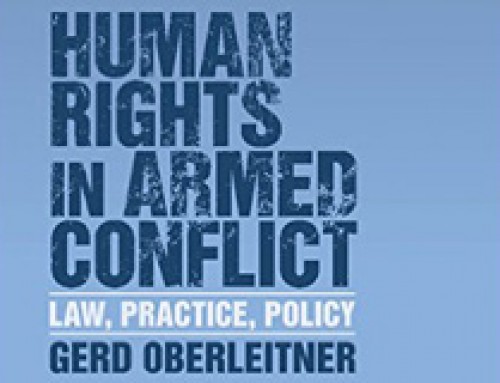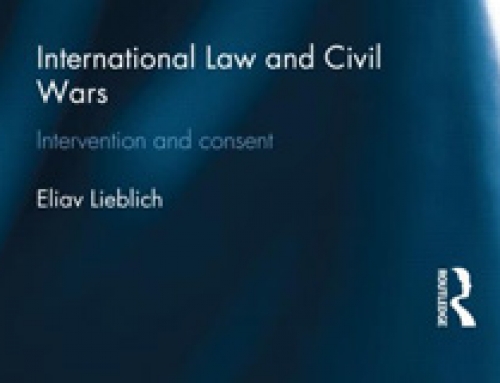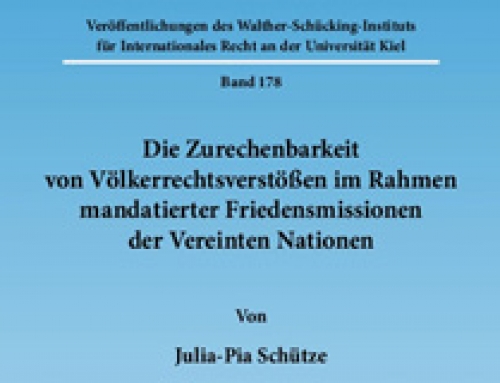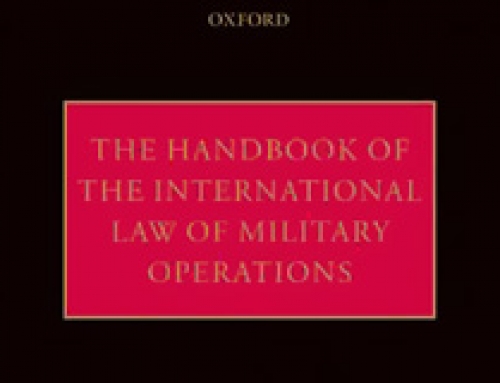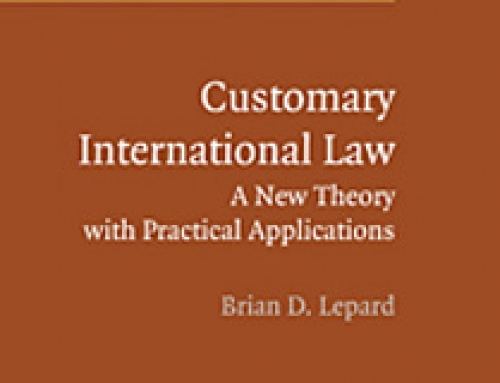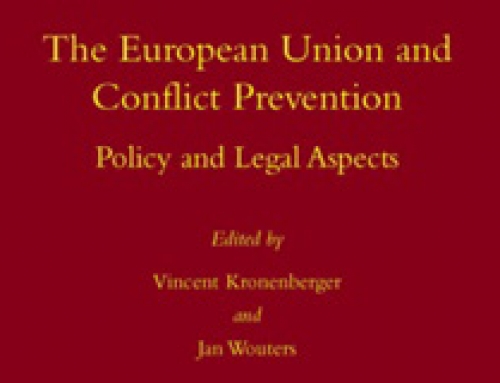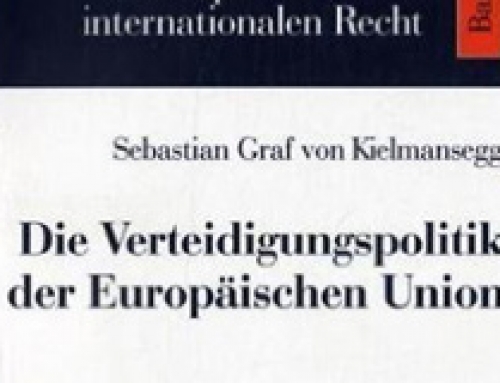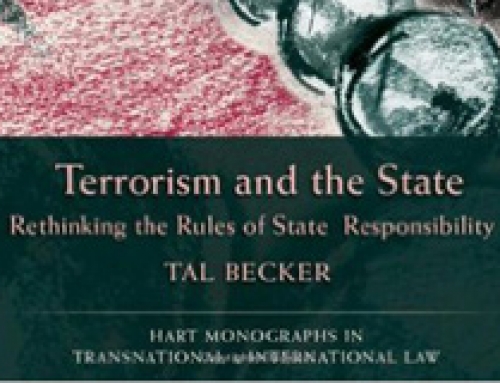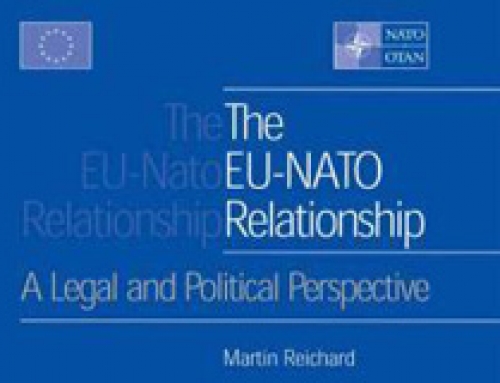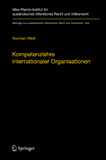
Norman Weiß, Kompetenzlehre internationaler Organisationen (Theory of the Powers of International Organisations) (Springer, 2009) 540 + xviii pp., ISBN: 978-3-642-03377-3.
Competence is a defining feature of international organizations much in the same way as sovereignty (still) is a defining feature the State, albeit for different reasons. Both concepts, competence and sovereignty, may be understood as a set of legal capacities. States are the original subjects of the international legal system and as such enjoy a comprehensive range of capacities under international law, which collectively constitute their sovereignty.1 By contrast, since international organizations are created by States for certain specified purposes, their competences depend on the will of their founders and are limited to those capacities which the latter have conferred upon them either expressly or by implication.2 Accordingly, whereas States enjoy legal capacities because they exist, international organizations exist because they enjoy certain legal capacities. To put the same point differently, sovereignty is a necessary attribute or consequence of the State’s existence, whilst the conferral of competence is an integral aspect of the creation of an international organization. Unlike State sovereignty, the competences of international organizations thus serve an ontological function.
Given the proliferation of international organizations and the significant expansion of their functions in recent decades, it is surprising that their competences have so far received only modest attention in the literature, in particular compared to the far more extensive treatment of State sovereignty. The book under review here, a monograph by Norman Weiß published as volume 209 of the magnificent Beiträge zum ausländischen öffentlichen Recht und Völkerrecht series of the Max Planck Institute for Comparative Public Law and International Law in Heidelberg, seeks to address this imbalance by developing a general theory of the powers (Kompetenzlehre) of international organisations.
The book falls into three main parts. The first part is devoted to a review of the historical development of international organizations with a particular emphasis on the emergence of what the author calls certain practical models of cooperation. It begins with a detailed study of the German Confederation created by the Congress of Vienna in 1815, before turning to the emergence of international administrative unions during the second half of the 19th Century, the German Customs Union established in 1834 and finally the League of Nations, the first modern international organization of universal reach. The second part of the book examines in considerable detail the respective functions and institutional structures of the United Nations and the European Union in order to illustrate the dynamic relationship between progressive integration and State sovereignty. Building on the preceding sections, the third part attempts to develop a general theory of the competences of international organizations which clarifies the notion of competence and explains its role as an ordering element (Ordnungselement) in the constitutionalization (Verfaßtheit) of international organizations.
Plainly, Weiß has set himself a high bar. His general theory of the powers of international organizations is meant to provide ‘the instruments for analysing this form of international co-operation in order to understand more profoundly and deal adequately with the conditions, effects, and problems of international organisations’ (at 432).3 There is no doubt that formulating a general theory of the competences of international organizations that is capable of resolving some of the practical problems faced by international organizations and their member States would be a major achievement and a welcome addition to the literature. Unfortunately, the book falls short of supplying the building-blocks for such a general theory.
While the historical review undertaken in the first part certainly helps to put matters into perspective and to identify certain recurring themes, at the end of the day it makes only a limited contribution towards the overall aim of the monograph. The detailed discussion of the intricacies of the German Confederation in particular seems unwarranted. As Weiß himself points out, the German Confederation cannot be understood as a proto-type international organization and as such has had no direct effect on the subsequent development of international practice in this area. The lessons that the author attempts to draw from the German Confederation for modern international organizations are therefore limited (see at 361). More problematic is the fact that Weiß seeks to derive a general understanding of the competences of international organizations primarily from an extended review of the mandate and institutional set-up of two organizations, the UN and the EU. Not only does the small number of organizations selected for analysis and their particular features call into question the representative nature of his analysis,4 but it is difficult to see what exactly an account of the structure and practice of these two organizations can actually prove. By describing, for instance, the Security Council’s recent practice under Chapter VII of the UN Charter or the composition and powers of the European Parliament and other institutions of the EU, Weiß is treading on a well-worn path. The conclusions he draws from analyzing the institutional law of the UN and the EU are rather broad. Thus, he tells us that the UN and the EU are constituted associations of States which possess a legal order and carry out their activities on the basis of that legal order. They are subject to continuing development, but need to be based on an underlying consensus about their respective purposes and institutional design in order to provide a stable framework for international cooperation (at 322).5 Although undoubtedly true, these points are not particularly striking or analytically inspiring.
The same may be said about the third part of the book, which sets out the author’s general theory of competences. Weiß begins by identifying the defining feature of competence as the conferral upon an entity of certain tasks, decision-making authority and, as appropriate, the necessary means to implement its decisions (at 343).6 He then classifies competences into different categories depending, amongst other things, on their purpose and examines the different ways in which such competences may be conferred upon international organizations. Although in many respects helpful, the discussion here is relatively brief and does not move much beyond the current state of the literature. For example, Weiß devotes only a single paragraph to the role that the doctrine of effet utile plays in legitimizing the competences of international organisations, even though a more detailed analysis beyond the practice of the EU would be most appropriate. Rather than developing his theory further, at this point the author proceeds to study how the competences of international organizations are exercised in two specific areas: the adoption of legal acts and the conclusion of international agreements.7 In a final step, Weiß promises to pull together the preceding historical, practical and theoretical considerations into a denser form and develop them into a general theory of competences along three lines (at 383): the question of competence conflicts, the control over the exercise of competences and the legal effect of ultra vires acts. Once again, the discussion is helpful in some respects, but underdeveloped in others. For instance, Weiß makes the useful point that competence conflicts are an inevitable aspect of the legal existence of international organizations,8 but his suggestion that such conflicts need to be identified and resolved through recourse to Article 31 of the Vienna Convention on the Law of Treaties appears to state the obvious. Could other rules and principles of international law applicable in cases of normative conflicts and norm accumulation not be pressed into service more usefully?9 However, reading these passages raises a more fundamental question of method: it never transpires how the study of competence conflicts, the control over the exercise of competences and the legal effect of ultra vires acts was meant to add up to a general theory of the powers of international organizations.
Overall, this is a book rich in potential and promises, but it ultimately disappoints on both of these counts. In essence, the general theory developed by Weiß can be stated thus: by channelling the activities of international organizations, their competences play both an enabling as well as a delimiting function. They contribute to greater certainty and transparency and serve not only as a means to preserve the constitutional order of international organizations, but also as a way to progressively develop them through subsequent institutional and State practice. The trouble is that such a general theory appears to be too general to serve as a useful analytical tool for resolving the practical legal problems encountered by international organizations, as intended by the author. Perhaps it would have been more fruitful to focus on specific aspects of the competences of international organizations, for instance the tension between systematic integration and State sovereignty and investigate how the conferral of powers onto international organizations impacts on State sovereignty. Several ideas, such as the concept of an ‘emergency competence’ (Notstandskompetenz), of which the UN General Assembly’s Uniting for Peace resolution provides a text-book example, could have been explored in more detail. Promising analytical categories, such as the distinction between the breadth, depth and density of competences (at 350), could also have been elaborated further. In addition, more could have been said about what particular problems a general theory of competences could help to resolve. Little mention is made, for instance, of whether a better understanding of the conferral of competences onto international organizations could assist in resolving the question of concurrent or secondary liability of international organizations and their member States under the law of international responsibility. While the monograph contains a range of helpful pointers towards a general theory of the powers of international organizations, it suggests that such a theory needs to be developed at a higher level of specificity to be of real practical utility.
Published in the International Organizations Law Review
1 Ian Brownlie, Principles of Public International Law (7th, 2008), 106.
2 Separate Opinion of Judge Gros, Interpretation of the Agreement of 25 March 1951 between the WHO and Egypt, Advisory Opinion (1980) ICJ Rep. 73, 103.
3 Text cited from the English summary of the book.
4 The author suggests that the EU should be placed into ‘a category of its own compared to classical international organizations’, because its tasks ‘cover a plethora of issues that normally fall into a State’s competency’ (at 435, text quoted from the English summary). Considering its mandate, in particular under Chapter VII of the Charter, a strong argument could be made for treating the UN as a special case as well. One is left to wonder, therefore, how focusing on these two organizations could yield a ‘general’ theory.
5 The original reads: ‘Vereinte Nationen wie Europäische Union sind verfaßte Zusammenschlüsse von Staaten, die eine rechtliche Ordnung aufweisen und nach dieser rechtlichen Ordnung funktionieren. Sie sind dabei Entwicklungen unterworfen und für gewandelte Ausrichtungen offen. Um dabei aber gleichzeitig handlugsfähig und stabil zu beliben, müssen politische Systeme and damit auch umfassend angelegte Organisationen wie die Europäische Union und die Vereinten Nationen über einen strategischen Grundkonsens über Zweck, Zielsetzung und Ausgestaltung verfügen.’ (Footnote omitted.)
6 In the words of the author: ‘Kennzeichnend für Kompetenzen ist also … daß einer bestimmten Stelle eine Aufgabe zugewiesen, Entscheidungsbefugnis und gegebenenfalls auch die notwending Mittel zur Durchsetzung der getroffenen Entscheidung eingeräumt werden.’
7 Strangely, the section discussing the treaty-making capacities of international organizations is barely longer than two pages.
8 Dan Sarooshi takes this a step further by suggesting that international organizations are places for the continuing contestation of sovereignty and sovereign values: see Danesh Sarooshi, International Organizations and Their Exercise of Sovereign Powers (2005).
9 Generally, see UN doc. A/CN.4/L.682, Report of the Study Group on the Fragmentation of International Law, Finalized by Martti Koskenniemi, 13 April 2006.

